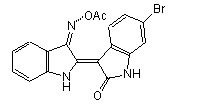Talin-1 Antibody (YQ-16)
- 产品型号: santacruz SC-81805
- 简单描述
- mouse monoclonal IgG3 provided at 100 µg/mlrecommended for detection of Talin-1 of mouse, rat and human origin by WB, IP, IF, IHC(P) and ELISA
SANTA CRUZ BIOTECHNOLOGY, INC.
Talin-1 (YQ-16): sc-81805
Santa Cruz Biotechnology, Inc. 1.800.457.3801 831.457.3800 831.457.3801 Europe +00800 4573 8000 49 6221 4503 0 www.scbt.com
BACKGROUND
Focal adhesions were identified as areas within the plasma membrane of
tissue culture cells that adhere tightly to the underlying substrate. In vivo,
these regions are involved in the adhesion of cells to the extracellular matrix.
Paxillin and vinculin are cytoskeletal, focal adhesion proteins that are components
of a protein complex that links the Actin network to the plasma
membrane. Vinculin binding sites have been identified on other cytoskeletal
proteins, including Talin-1 and α-actinin. In addition, vinculin, Talin-1, Talin-2
and α-actinin each contain Actin binding sites. Expression of vinculin, Talin-1
and Talin-2 have been shown to be affected by the level of Actin expression.
α-actinin has been shown to link Actin to integrins in the plasma membrane
through interactions with the vinculin and Talin complex or by a direct interaction
with integrin. Talin-2 is similar to Talin-1 but shows distinct patterns of
expression and cannot compensate for the loss of Talin-1.
REFERENCES
1. Burridge, K., et al. 1988. Focal adhesions: transmembrane junctions
between the extracellular matrix and the cytoskeleton. Annu. Rev. Cell
Biol. 4: 487-525.
2. Gilmore, A.P., et al. 1992. Further characterization of the Talin-binding site
in the cytoskeletal protein vinculin. J. Cell Sci. 103: 719-731.
3.Wood, C.K., et al. 1994. Characterisation of the paxillin-binding site and
the C-terminal focal adhesion targeting sequence in vinculin. J. Cell Sci.
107: 709-717.
4. Gluck, U., et al. 1994. Modulation of α-actinin levels affects cell motility
and confers tumorigenicity on 3T3 cells. J. Cell Sci. 107: 1773-1782.
5. Schevzov, G., et al. 1995. Impact of Actin gene expression on vinculin,
Talin, cell spreading, and motility. DNA Cell Biol. 14: 689-700.
6. Hemmings, L., et al. 1996. Talin contains three Actin-binding sites each of
which is adjacent to a vinculin-binding site. J. Cell Sci. 109: 2715-2726.
7. Gilmore, A.P., et al. 1996. Regulation of vinculin binding to Talin and Actin
by phosphatidyl-inositol-4-5-bisphosphate. Nature 381: 531-535.
CHROMOSOMAL LOCATION
Genetic locus: TLN1 (human) mapping to 9p13.3; Tln1 (mouse) mapping to
4 B1.
SOURCE
Talin-1 (YQ-16) is a mouse monoclonal antibody raised against recombinant
Talin-1 of human origin.
PRODUCT
Each vial contains 100 μg IgG3 in 1.0 ml PBS with < 0.1% sodium azide and
0.1% gelatin.
STORAGE
Store at 4° C, **DO NOT FREEZE**. Stable for one year from the date of
shipment. Non-hazardous. No MSDS required.
APPLICATIONS
Talin-1 (YQ-16) is recommended for detection of Talin-1 of mouse, rat and
human origin by Western Blotting (starting dilution 1:200, dilution range
1:100-1:1000), immunoprecipitation [1-2 μg per 100-500 μg of total protein
(1 ml of cell lysate)], immunofluorescence (starting dilution 1:50, dilution
range 1:50-1:500), immunohistochemistry (including paraffin-embedded
sections) (starting dilution 1:50, dilution range 1:50-1:500) and solid phase
ELISA (starting dilution 1:30, dilution range 1:30-1:3000).
Suitable for use as control antibody for Talin-1 siRNA (h): sc-36610, Talin-1
siRNA (m): sc-36611, Talin-1 shRNA Plasmid (h): sc-36610-SH, Talin-1 shRNA
Plasmid (m): sc-36611-SH, Talin-1 shRNA (h) Lentiviral Particles: sc-36610-V
and Talin-1 shRNA (m) Lentiviral Particles: sc-36611-V.
Molecular Weight of Talin-1: 230 kDa.
Positive Controls: RAW 264.7 whole cell lysate: sc-2211.
RECOMMENDED SECONDARY REAGENTS
To ensure optimal results, the following support (secondary) reagents are
recommended: 1) Western Blotting: use goat anti-mouse IgG-HRP: sc-2005
(dilution range: 1:2000-1:32,000) or Cruz Marker™ compatible goat antimouse
IgG-HRP: sc-2031 (dilution range: 1:2000-1:5000), Cruz Marker™
Molecular Weight Standards: sc-2035, TBS Blotto A Blocking Reagent:
sc-2333 and Western Blotting Luminol Reagent: sc-2048. 2) Immunoprecipitation:
use Protein A/G PLUS-Agarose: sc-2003 (0.5 ml agarose/2.0 ml).
3) Immunofluorescence: use goat anti-mouse IgG-FITC: sc-2010 (dilution
range: 1:100-1:400) or goat anti-mouse IgG-TR: sc-2781 (dilution range:
1:100-1:400) with UltraCruz™ Mounting Medium: sc-24941. 4) Immunohistochemistry:
use ImmunoCruz™: sc-2050 or ABC: sc-2017 mouse IgG
Staining Systems.
DATA
SELECT PRODUCT CITATIONS
1. Ah Kioon, M.D., et al. 2010. Adrenomedullin increases fibroblast-like synoviocyte
adhesion to extracellular matrix proteins by upregulating integrin
activation. Arthritis Res. Ther. 12: R190.
RESEARCH USE
For research use only, not for use in diagnostic procedures.


